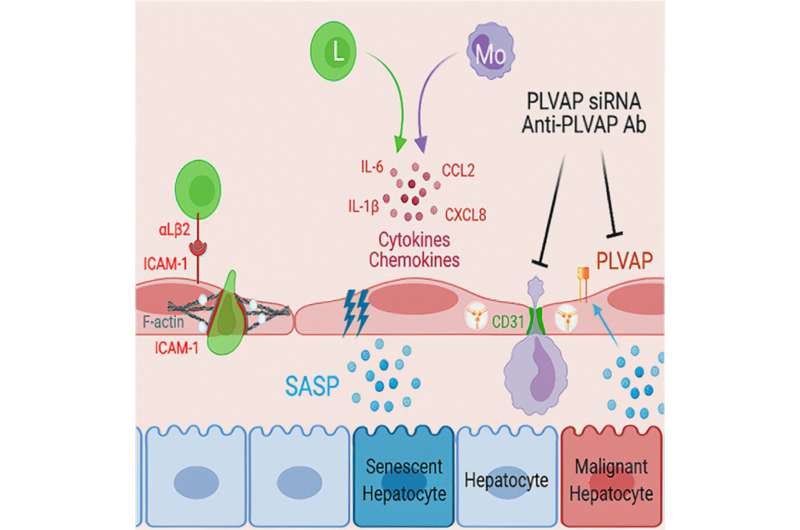This article has been reviewed according to Science X's editorial process and policies. Editors have highlighted the following attributes while ensuring the content's credibility:
fact-checked
peer-reviewed publication
trusted source
proofread
New inflammatory mechanisms unveiled in the setting of liver disease and liver cancer

An international study involving Birmingham researchers identified for the first time how a protein found in the endothelium supports the transfer of specific immune cells, called macrophages, from the blood into the liver, causing inflammation—which can promote liver disease and liver cancer.
The results, published in iScience, could lead to further experimental studies and potential treatments that may help control the levels of macrophages in the liver, preventing cancer and supporting healthy healing of the liver.
This newly discovered mechanism involves the molecules secreted by senescent liver cells—cells that have stopped multiplying—in liver disease patients. There was previous evidence that these secretions, known as senescence-associated secretory phenotype (SASP), drive recruitment of immune cells from the blood to the liver; but the molecular mechanisms of this were not clear.
By studying samples of liver tissue from patients with liver disease and then setting up models in the laboratory to study immune cell recruitment, the research team have shown that these pathways involve an endothelial protein called plasmalemma vesicle-associated protein (PLVAP), which can support the recruitment of macrophages.
Birmingham researchers, including Professor Shishir Shetty, Alex Wilkinson and Daniel Patten, collaborated with international groups from the universities of Edinburgh, Cambridge, Minia (Egypt) and Turku (Finland), with funding from a Newton Prize, an annual award enabling international research partners to work together to address some of the world's most pressing health and development issues.
Chronic liver disease is a global health burden accounting for approximately two million deaths each year worldwide. Ranking the second most common cause of premature death in the U.K., chronic liver disease is also a major risk factor for developing hepatocellular carcinoma.
Study lead Shetty, Professor in Liver Tumor Immunology at the University of Birmingham's Institute of Immunology and Immunotherapy, co-lead of the NIHR Birmingham Biomedical Research's Inflammatory Liver Disease research theme, and Honorary Consultant Hepatologist at the Queen Elizabeth Hospital, commented, "Previous studies have shown that senescence in liver disease and liver cancer can be a double-edged sword.
"Our study highlights how we could potentially target blood vessels to prevent the detrimental consequences of senescence-driven inflammation while maintaining the protective effects of senescence, such as preventing malignant transformation of cells."
More information: Alex L. Wilkinson et al, The senescent secretome drives PLVAP expression in cultured human hepatic endothelial cells to promote monocyte transmigration, iScience (2023). DOI: 10.1016/j.isci.2023.107966




















